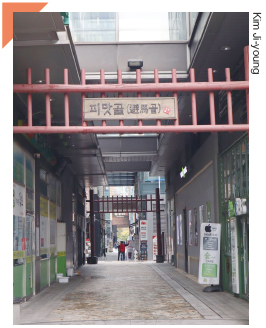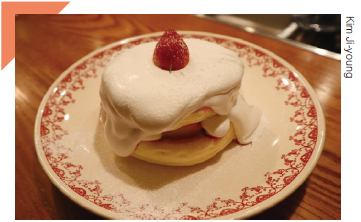Many places are recommended for university students to go to relax or play. The UOS Times recommends Iksun-dong for students as the perfect place to experience the history and tradition of Seoul. Iksun-dong is famous for traditional Korean-style houses; called Hanok, but this is not the only thing. Iksun-dong is a mix of traditional and contemporary styles. Pimagil and Iksun-dong Hanok Village are the places where The UOS Times recommends for the University of Seoul (UOS) students to visit in Iksun-dong.


Pimagil (also called Pimatgol) is a back alley of a main road where government officers in the Joseon Dynasty used to pass by on horses. The literal meaning of Pimagil is “a road for avoiding horses”. In that period, ordinary people were required to pay their respects to government officials by bowing down to the ground whenever they came across one of them on the road. To avoid this inconvenience, these commoners started to use a smaller alley, which is situated behind the main road.
In the Joseon Dynasty, Pimagil was divided into the upper part of Jong-no and the southern part of Jong-no. As more and more people passed through this alley, it had another name, ‘Unjongga’. It is a word that describes people as gathering like clouds. Gradually, the number of bars and restaurants on this street increased. Eventually, Pimagil became one of the most popular places in the area.

These days, many people visit this attraction to eat its famous food, bindaetteok. Bindaetteok (mung-bean pancake, translated in English) is usually eaten with makgeolli (raw rice wine, translated in English). Iksun-dong is famous for its history and taste, and there are even restaurants that have been serving bindaetteok and makgeolli for almost 70 years. Visiting restaurants that are serving these cuisines will make a trip to Iksun-dong perfect.
Nowadays, the structure of Pimatgol has changed a lot. Many contemporary buildings have been built on this site, so it seems difficult to figure out its original shape. However, efforts have been made to maintain the shape of Pimagil .

Most people think of the Hanok villages in Jeonju and Bukchon when they see this traditional style housing. Despite this similarity, the place The UOS Times will introduce is a place you can easily visit and find the tradition and future of Hanok together. It is the Iksun-dong Hanok Village. Although the Japanese Imperialism Government redeveloped this place, Jeong Se-gwon, a Korean independence activist and a real estate developer, purchased all of the land of Iksun-dong Hanok Village in the 1930s. After succeeding to gain this site, he constructed some traditional housing facilities to make it possible for commoners in Seoul to reside in their own home.

Iksun-dong Hanok Village has some interesting features compared with other traditional villages. First of all, this place was built earlier than Buk-chon Hanok Village. Also, Iksun-dong Hanok Village has been known as a well-composed Hanok village. That is because it is composed of houses that people actually live in and use as stores. While it is easy to think that Hanok villages are usually only for visiting and not actually used permanently, this is a real-life Hanok village with many restaurants, shops, and living spaces. This makes Iksun-dong Hanok Village different from other Hanok Villages.
Recently, Iksun-dong Hanok Village has been popular for its’ unique atmosphere. People who have been there may say that it is a place where you can feel the luxuriousness of the past and the sophistication of modern times. In this luxurious Hanok you can enjoy foods, teas or modern fashion. Also, it has very narrow alleys so vehicles can’t go through it. It is a good place for people who are tired of noisy and busy big roads to rest and relax.
These days Iksun-dong has been so popular that people have to wait to get in to certain cafes or restaurants. The UOS Times visited Iksun-dongs’ most popular. It’s famous for its’ dessert menu item, supple pancakes, so whenever you go, you have to wait for at least 40 minutes. During the waiting time, the cafe offers a cup of tea for every person waiting outside. Once you get in and order the pancakes, it takes about 30 minutes to get it. The pancakes are so soft and creamy and it tastes good with a hot americano. Eating unusual menu items in a traditional Hanok was a different experience and The UOS Times hopes students of UOS can experience it too, by visiting Iksun-dong Hanok Village.
The places in Iksun-dong The UOS Times recommended were Pimagil and Iksun-dong Hanok Village. These places are quite near to UOS, so students can visit and have fun or relax there, and now it must be more meaningful, as you have read this article and know about the meaning and history of the place.
Kim Ji-young
zzero9999@uos.ac.kr

